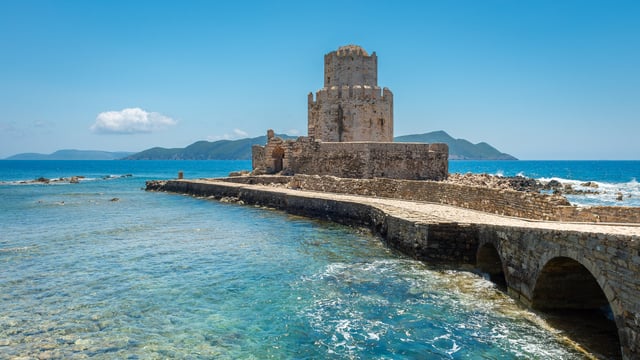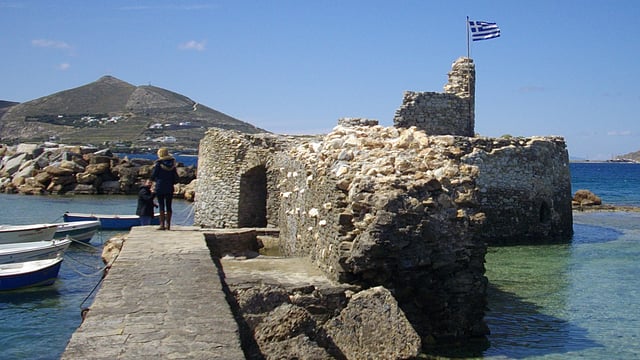Venetian Castles & Forts in Greece
The enduring legacy of the Republic of Venice is etched into the landscapes of modern-day Greece. During their centuries-long rule following the Fourth Crusade in 1204, the Venetians constructed a network of robust fortresses and castles. These structures were vital in maintaining control over strategic routes and valuable territories, predominantly during repeated conflict with the Ottomans. Visitors to Greece today can trace this history of Venetian rule and subsequent Ottoman conquest, particularly in regions such as the Ionian and Cycladic Islands, and the Peloponnese and Crete.
Why Venetian Castles in Greece?
The Republic of Venice (697 AD – 1797) expanded its territories into regions of present-day Greece, particularly the Ionian and Cycladic Islands, Peloponnese, and Crete, following the end of the Fourth Crusade in 1204. These maritime and overseas dominions were referred to as the Stato da Màr.
Venice did not have a large army, but they did have a formidable naval fleet. Their strategy to maintain control over their overseas territories was to build a series of fortresses. They were built to secure significant sea routes and protect valuable lands, these structures stood as bastions of Venetian power and control. The fortresses, often positioned on high vantage points, offered strategic advantages in times of conflict. They also served as administrative centres, from where the Venetians would exert their rule. One castle of note is the Palamidi Fortress in Nafplio, Peloponnese. An architectural masterpiece, the fortress provides an unparalleled view of the city and the Argolic Gulf. Similarly, the Fortezza in Rethymno, Crete, stands as an imposing emblem of the Venetian era.
As the Venetians strengthened their grip on these territories, the culture, society and art of the region underwent a transformation. This period witnessed the fusion of Venetian and local Greek customs, a cultural synthesis that manifested in various facets of daily life, from food to language and art.
The emergence of the Ottoman Empire in the late 13th century, however, brought a new wave of challenges for the Venetian Republic. The ensuing Ottoman-Venetian Wars were a series of conflicts fought intermittently over several centuries. The fortresses and castles, initially designed to exert power and control, they began to serve as a line of defence against the Ottomans. The Fortress of Koules in Heraklion on Crete, bears testament to the tug-of-war between Venetian and Ottoman forces. Despite repeated onslaughts, Koules managed to resist Ottoman capture until the end of the Cretan War in 1669.
The Seventh Ottoman-Venetian War from 1714 to 1718 marked the end of Venice’s territorial presence in Greece. The Ottomans were victorious, and they either adapted Venetian fortresses for their own purposes or they were left to decay and ruin.
Today, these Venetian structures are a witnesses to a turbulent past, enticing visitors with their architectural grandeur and historical significance. They provide a unique insight into the complex historical narrative of the region, from the rise and fall of the Venetian Republic to the ensuing Ottoman rule. Visiting these sites is not just an exploration of ancient ruins; it’s an engaging encounter with the layers of history that have shaped the cultural identity of the modern nation state of Greece.
Create Your Greece Itinerary & Travel Lists
Venetian Castles in Greece
Acrocorinth
Acrocorinth, the acropolis above the ancient city of Corinth, has structures that are almost certainly prehistoric in age. But the earliest securely dated fortifications date to the 4th century BC. Much of the ruins we see on the acropolis were built during the medieval: Byzantine, Ottoman, Venetian and Early Modern eras. The ruins within the walls surrounding the hilltop are from the Ottoman settlement. Amongst other features from different time periods, visitors can see the remnants of a mosque, fountains and houses.

Antirrio Fortress
Given the strategic location on the north side of the western entrance to the Gulf of Corinth, the fort has been important for the Byzantines to the Ottomans. The fortress is surrounded by sea on three sides and a moat on the fourth. It has been destroyed and restored numerous times. Much of what we see today was built by the Venetians, during their second period of occupation. This lasted until 1699 when it was surrendered to the Ottomans. Now in the hands of the Ministry of Culture and used for cultural events.

Castle of Santa Maura
The first structure, a defensive station, to protect the island of Lefkada from raids from the mainland, was built in 1300 by the Frankish ruler Giovanni Orsini. Since then the castle has been significantly modified and occupied by almost everyone, from the Venetians to the Ottomans, from the French to the Russians, from the British to the Greeks. Although most of the buildings within the walls were destroyed, many features have survived, including the 14th century church dedicated to Saint Maura and the English prison.

Fortezza Rethymno
Visible from most points around the city of Rethymno is the Venetian stronghold of Fortezza. It was built between 1540 and 1570 when the island was under Venetian rule to protect the commercial port against Ottoman attack. In 1646 Fortezza fell to the Ottomans. Besides the outer fortifications, a number of internal features have survived. These include the Ibraham Han Mosque and the late 19th century church of Agios Theodoros Trichinas. From the fort visitors get panoramic views of Rethymno and beyond.

Fortress of Palamidi
An impressive fortress built by the Venetians between 1711 and 1714. The fortress, 216 meters above sea level on the highest point above the town of Nafplio, has wonderful views over the town, the Argolic Gulf and the sea and countryside beyond. This is a typical Venetian fortress with 8 bastions, each of which can be visited. With an hour, you will see a lot of the castle, but you can easily spend 2 hours. It is possible to drive up to the castle, or climb the 900+ steps from the town. Visitors all say, the view is worth the walk alone.

Frankish Castle, Parikia
In the historical centre of Parikia is an area called Kastro (castle). Not much is left of that castle now, built in 1260 by the Venetian Duke of Naxos. What was the castle’s elliptical outline can be seen from above in the layout of the streets. The most striking physical remnant is a rectangular tower with some fragments of the castle walls. The tower and walls were constructed using dressed stone from ancient buildings. It is said that elements of the Temple of Athena are included in these walls.

Methoni Castle
Methoni Castle occupies the peninsular that juts out south of the town of Methonis. The Venetians built most of the castle and its fortifications, constructing these on earlier fortifications, the remains of which can be seen in places. A deep moat separates the castle from the mainland, which is spanned by a stone bridge with 14 arches. At the southern most tip of the peninsular is the Bourtzi Tower, a striking octagonal structure that is thought to have been built in the 16th century.

Patras Castle
The castle was built in 551 AD on the remains of the ancient acropolis. It has remained in constant, although control of the castle changed hands frequently, until World War II. War. The first castle was constructed using the remains of Classical period buildings. One of the stone pieces re-used was the bust of a Roman statue, now said to be a ‘maiden’ that guards the city against disease. It has been controlled by the Franks, Venetians and the Ottomans. Today the castle is used for cultural events throughout the summer.

Rio Castle
Also known as the Castello de Morea, the fort is on the southern side of the western entrance to the Gulf of Corinth – facing Antirrio Fortress. Built in 1499 on the site of an ancient temple (remains are still visible) by the Ottoman Sultan Bayezid II. In 1687 it was taken by the Venetians who rebuilt it substantially. In 1715 the Ottomans recaptured and retained control until Greek Independence. Thereafter it was used as a prison. During WW2 it was used by the Germans as a military base.

Spinalonga
Although the island of Spinalonga has a fascinating Venetian and Ottoman history, it is better known today as a result of being the setting of Victoria Hislop’s 2005 novel The Island, and adapted for TV. An island on which those who suffered leprosy were quarantined from 1903 to 1957. Now the island is a popular day trip for tourists to Crete. Besides the ruined features of the hospital, visitors can also explore the Venetian fortress – one of the most important in the Mediterranean due to its strategic location.

Venetian Castle, Naoussa
The fishing harbour of Naoussa has many Byzantine features. The port is dominated by a circular known as the Venetian Castle. A castle was built at the end of the 13th century and into the start of the next century. In 1500 a circular tower was added as a protective measure against pirates. The tower is all that remains of the castle, which was destroyed when the Ottomans conquered the island of Paros in 1537. Remains of the sea wall can be seen underwater at the tower, more recent buildings have been built over the rest.














